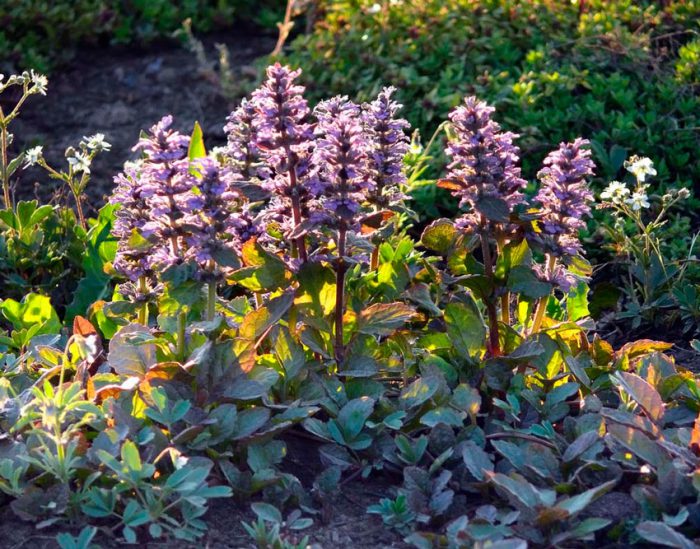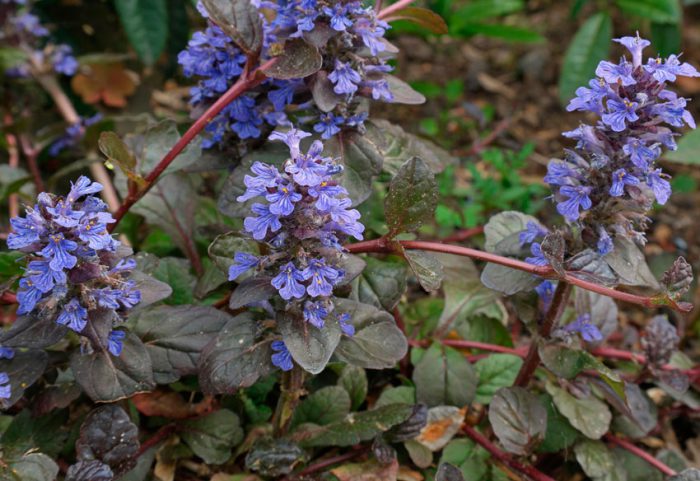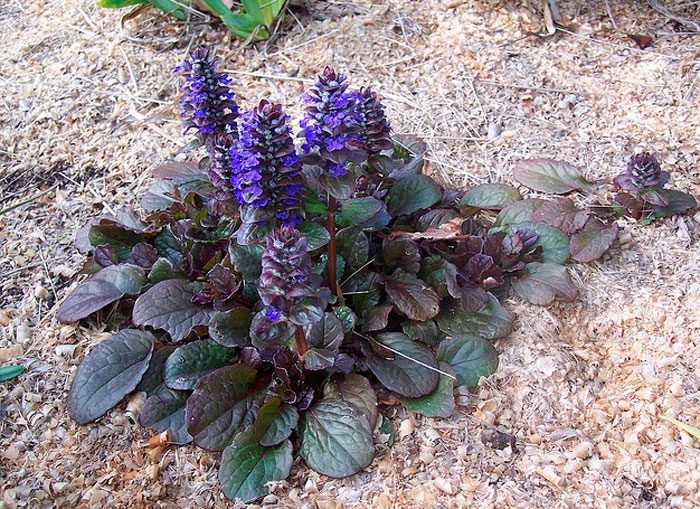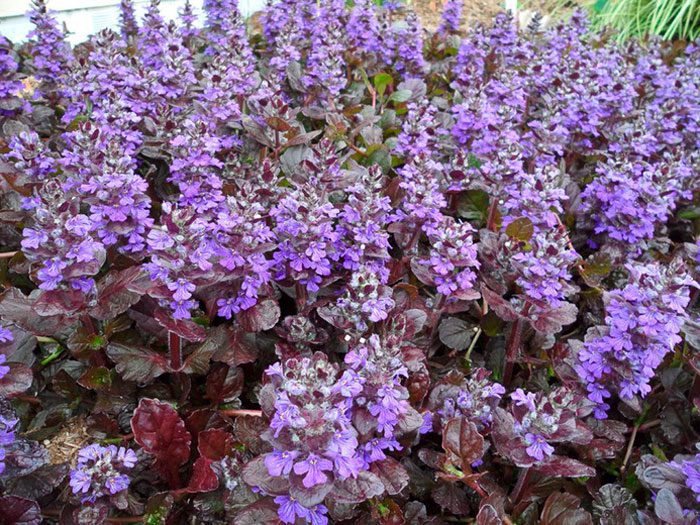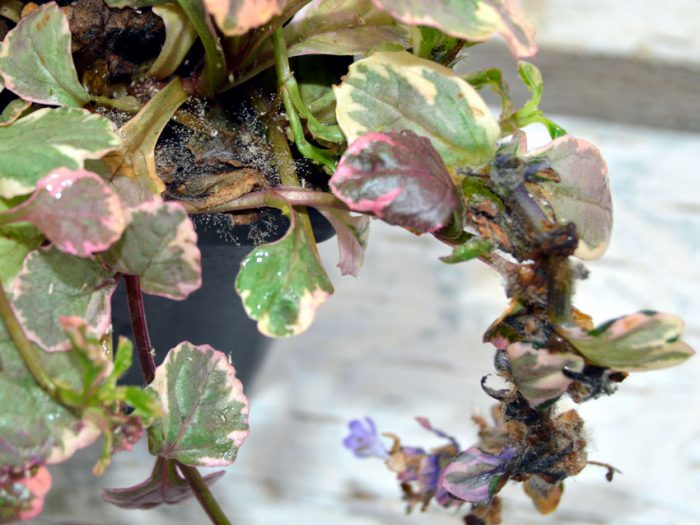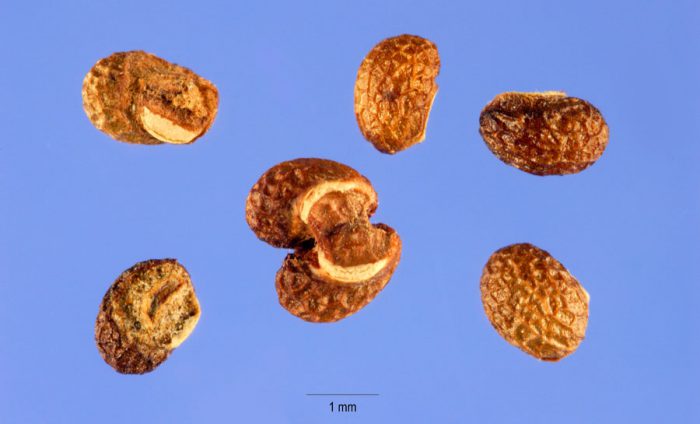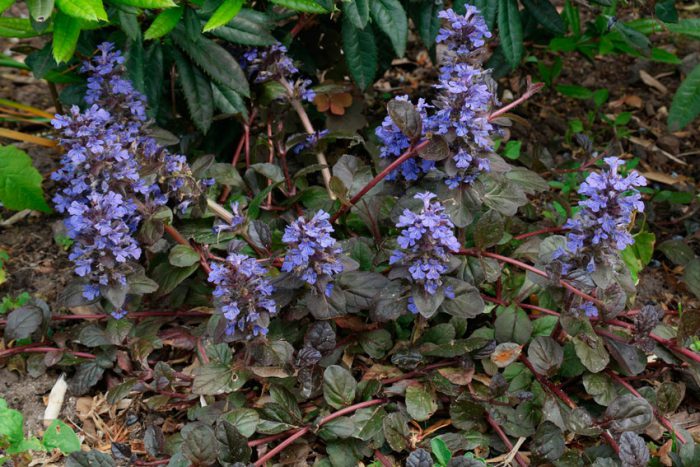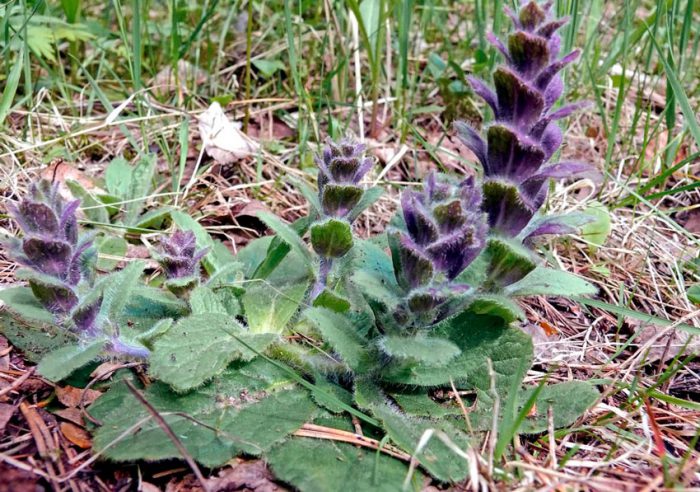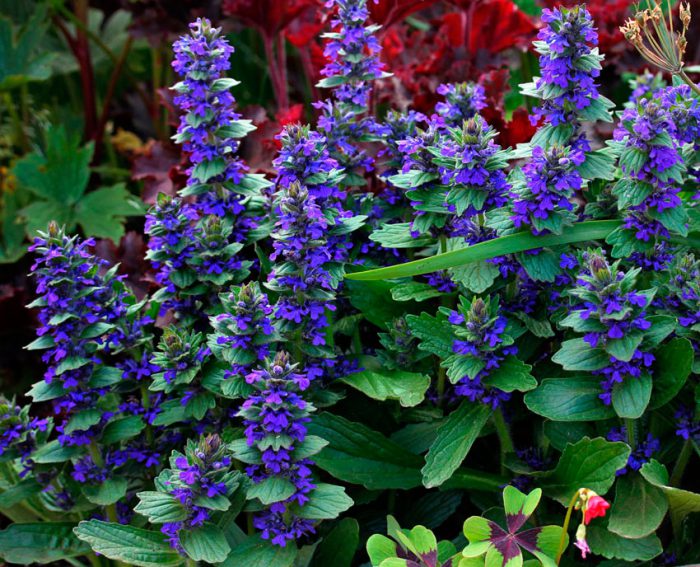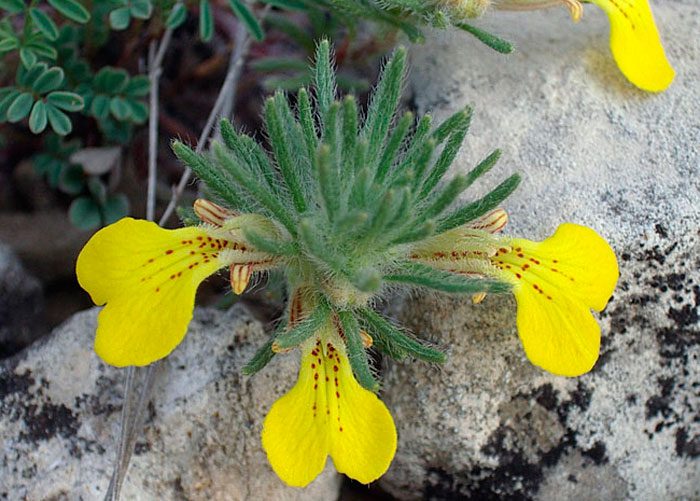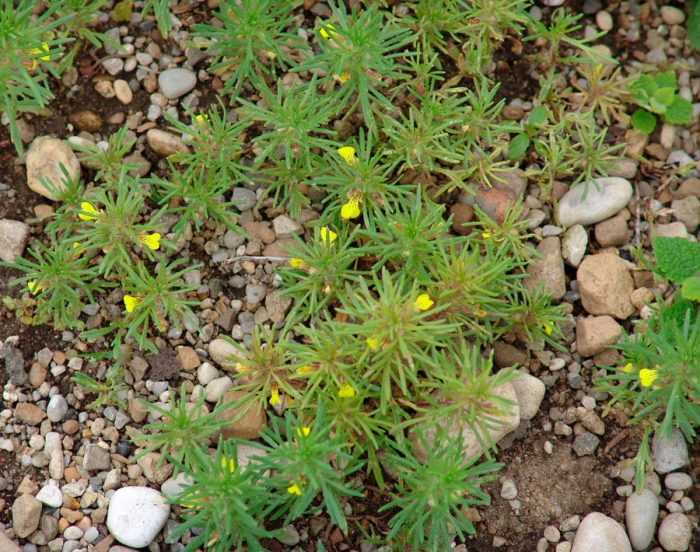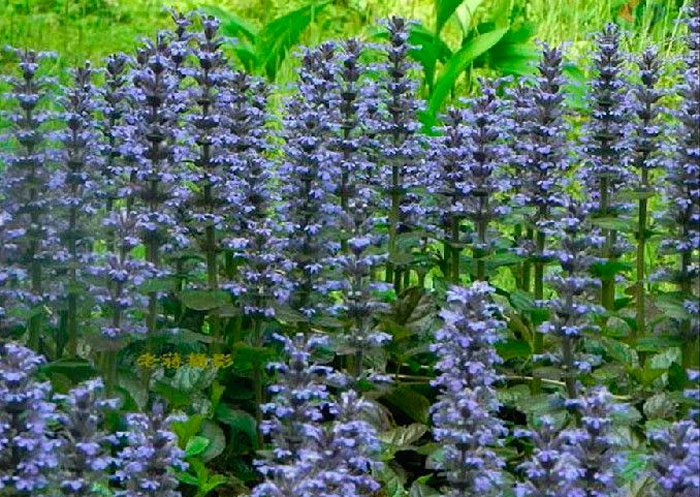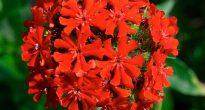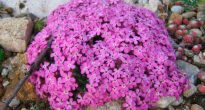The herbaceous plant tenacious (Ajuga), or ayuga, is a representative of the family of the lamellar or labiate. In Russia, such a plant is often called a non-wilting, Dubrovka, Dubnik, Nemirashka or Vologodka. On the territory of Eurasia and Africa, this herb in nature can be found everywhere, in the temperate latitudes of the Northern Hemisphere, about 70 species of Ayuga grow, and in Australia there are only 2 species of such a plant. Already from the name it becomes clear that the tenacious is distinguished by its high vitality. The most popular among gardeners is the pyramidal, creeping and Geneva tenacious. Turkestan tenacious, or rather, an extract from this plant, has a powerful tonic effect, and it is used in sports and clinical medicine.
Content
- 1 Features of the tenacious
- 2 Growing a tenacious seed
- 3 Caring for a tenacious in the garden
- 4 Tenacious after flowering
- 5 Types and varieties of tenacious with photos and names
- 5.1 Creeping insect (Ajuga reptans)
- 5.2 Pyramidal tenacious (Ajuga pyramidalis = Ajuga occidentalis)
- 5.3 Genevan tenacious (Ajuga genevensis)
- 5.4 Chio's tenacious (Ajuga chia)
- 5.5 Laxman's tenacious (Ajuga laxmanni)
- 5.6 Herringbone tenacious (Ajuga chamaecyparissus)
- 5.7 Turkestan tenacious (Ajuga turkestanica)
Features of the tenacious
Tenacious is a herbaceous semi-evergreen, evergreen, or deciduous plant that can be perennial or annual. The height of the bush can vary from 0.05 to 0.5 meters. The leaf plates are opposite. False whorls consist of blue, blue, purple or yellow flowers. All types of such a plant are distinguished by their undemanding soil and growing conditions. Gardeners, as a rule, cultivate decorative leafy and ground cover species and forms of ayuga. In landscape design, it is used for cultivation in rockeries, mixborders and rock gardens, and it is also cultivated as a ground cover plant.
Growing a tenacious seed
What time to sow seeds
Sow the seeds of the Ayuga directly into the open soil. If sowing is done for the first time, then the seeds can be purchased without any problems at a specialized store. Such seeds are highly germinating. Sowing seeds is carried out directly into open soil in spring, when it warms up properly. You can also sow Ayuga before winter in autumn. A suitable area should be well lit or shaded. Often, the tree trunk circle becomes the place for planting the tenacious.The fact is that this herb will not take nutrients from the soil that the tree needs. Ayuga grows best on well-cultivated garden soil or on nutritious moist loam. Before proceeding with sowing, the site must be dug up, while introducing organic matter into the soil (per 1 square meter from 10 to 15 kilograms) and a complex mineral fertilizer or double superphosphate (per 1 square meter, 100 grams).
How to plant correctly
If desired, in the store you can buy ayuga seedlings, which are sockets. They are planted in open soil from mid to late May. Such grass is not afraid of short frosts up to minus 8-10 degrees. For planting seedlings, you should choose a sunny dry day. A distance of 0.25–0.3 m must be kept between the bushes. The growth point must always remain above the ground surface. The ground near the bushes must be tamped. The planted plants need abundant watering, while trying not to expose the roots.
Caring for a tenacious in the garden
Caring for Ayuga is relatively easy. The bushes need to be watered systematically, and also to prevent their uncontrolled spread. Before young leafy plates appear on the planted plants, they need to be protected from direct rays of the sun, and the survivor needs timely watering, make sure that the soil near the bushes never dries out. After the rosettes start to grow, the plants are practically not watered, this should be done only during extreme heat or a long dry period. Remember that such grass can grow extremely quickly, so it is necessary to constantly monitor so that it does not spread into areas not intended for it. A fence can be made around the perimeter of the site, for this you need to surround the plant with stones, and only slightly press them into the soil. To preserve the spectacular appearance of decorative leafy species of Ayuga, it is recommended to cut off the inflorescences in a timely manner.
Reproduction of the tenacious
Such a herbaceous plant can be propagated by seed and vegetative method. But it should be borne in mind that it is recommended to grow ayuga from seeds only during the initial planting. If you cultivate varietal plants, then remember that the seeds collected from them are not able to retain the characteristics of the mother plant. In this regard, they are propagated by rosettes. Vegetative reproduction of the tenacious is carried out in early spring or in autumn (until the second decade of September). The bushes should cut off the overgrown sockets, which are transplanted to a new place one by one or several pieces. It happens that the outlet has only 1 thin spine, despite this, it can quite successfully take root in a new place. In the event that the outlet is separated once a year, then when planting between the bushes, a distance of 15 centimeters should be observed. If this procedure is carried out once every 2 years, then at least 0.25 m should be left between the plants. After the rosettes take root and start growing, they stop watering.
Ayuga can reproduce itself by self-sowing, but at the same time the grown young plants will not be able to preserve the varietal characteristics of the mother bush. To prevent self-seeding, peduncles should be cut off in time. So, in deciduous species, this should be done when the arrow just begins to grow, and in flowering species, when they have faded. This lesson is quite laborious, but the basic care of the tenacious is very simple.


Watch this video on YouTube
Diseases and pests
Ayuga is highly resistant to diseases and pests. However, such a plant can be disturbed by slugs, which eat its delicate leaves at night. As a rule, slugs are activated at high humidity and low air temperatures.However, for such gastropods, a strip of crushed stone or gravel will become an almost insurmountable obstacle, such a "fence" is made around the site with the tenacious.
Tenacious after flowering
Seed collection
As already mentioned above, it is pointless to collect seeds, since they are not able to preserve the varietal characteristics of the mother plant, and also because the tenacious reproduces well by self-sowing. Experienced gardeners are advised to cut off the testes, and use sockets for reproduction.
Wintering
If the winters are snowy, then the plant will be able to survive them without shelter. In the event that there is practically no snow in the winter, the plantings will need to be covered with dried foliage or spruce branches. Young bushes should be covered for the winter.
Types and varieties of tenacious with photos and names
Gardeners cultivate not a very large number of species and varieties of tenacious, while all of them are ground cover plants.
Creeping insect (Ajuga reptans)
Under natural conditions, this species can be found in Asia Minor, North America, Europe and Iran, and it prefers to grow among shrubs, in forests and in wet meadows. Such a perennial plant has creeping rooting shoots, the height of which is 10–25 centimeters, with soft hairs on their surface. Rosette basal leaf plates gradually transform into a relatively long petiole. In this case, the stem leaf plates have an ovoid shape, they are sessile or have a short petiole, and the edge is notched-wavy. The entire bracts are pale blue at the base. Spike-shaped inflorescences consist of 6–8 bell-shaped flowers; pubescence is on the surface of their calyxes. The color of the corolla is blue or blue, they have a short, two-lobed upper lip. Such a plant blooms in May or June, and the flowering duration is about 20 days. This article tells about planting and caring for the creeping tenacious. Popular varieties:
- Arctic Snow. This variety was bred relatively recently. Wrinkled-corrugated leaf plates of spatulate shape and dark green color in length reach about 10 centimeters. In the center of the plate is a wide, ash colored stroke, it also has a white stroke and a green edge.
- Black Skallop... The height of the bushes does not exceed 5-10 centimeters. Shiny embossed leaves are painted in a very rich beet-purple color, the edge is uneven, wavy, the shape is similar to scallops. If the plant is grown in a sunny area, then the color of its foliage will be as deep and saturated as possible.
- Chocolite Chip... The bushes reach a height of only 5 centimeters. The length of small smooth all-edge sheet plates is about 6 centimeters, and the width is 2 centimeters, they have an elliptical shape. They are painted simultaneously in purple and dark green. If you grow such a plant in a shaded place, then its decorative qualities will not decrease.
- Multicolor... This plant is one of the most decorative. The color of its leaf plates can vary depending on how intense the lighting is. For example, if it grows in a shaded place, then its color will be dark green with stains of yellow and pink, and in a sunny place, the foliage is painted in a deep purple color, and there are scarlet and orange-yellow fragments on the surface.
- Burgundy Glow... This variety is quite popular among gardeners. Purple-purple leaf plates have a cream-colored edging, and in their central part there are red-pink shapeless spots. When grown in a shaded area, the foliage color is more intense.
- Sparkler... The color of the flowers is bright blue. There are a large number of small green leaves, on the surface of which there are strokes and strokes of white-pink or cream color.
The following varieties of creeping tenacious are also popular: Sparkler, Variegata, Catlins Giant, Dixie Chip, Toffee Chip, Rainbow, Silver Queen, Pink Elf, Arctic Fox, Brown Hets, Atropurpurea, Variegata Rubra, etc.
Pyramidal tenacious (Ajuga pyramidalis = Ajuga occidentalis)
The homeland of this species is Europe, it prefers to grow among bushes and on rocks. The height of the bushes is up to 25 centimeters. There is a long pile on the surface of the oval slightly serrated leaf plates. The length of the peduncles is no more than 10 centimeters, they are decorated with flowers of white, pink or deep purple color. Popular varieties:
- Lunar Landing... This very unusual variety has yellow flowers that are extremely difficult to describe. Created this variety by Riotto, and in his opinion this plant is as ugly as it is magnificent.
- Crisp... Large, crinkled leaf plates are colored green. The color of the flowers is blue.
- Metallica Crisp... Plant height is about 5 centimeters. Small, wrinkled leaf plates have a green-purple color with a metallic sheen.
Genevan tenacious (Ajuga genevensis)
In nature, the species is found in Asia Minor, Europe and Iran, such a flower prefers to grow on forest lawns and forest edges, in meadows and among shrubs. Shoot height varies from 0.05 to 0.4 meters. The leaf plates of the basal rosette have short petioles, while the stem plates are sessile, have an oblong elliptical shape and an edge with sharp teeth. The color of the flowers is blue, white or pink, they have a three-lobed lower lip and a very small upper lip. The flowers are collected in whorls of 2-6 pieces, which are part of the spike-shaped inflorescences. Bracts large-toothed or trilobate. The plant blooms in May – July. In this species, the stems do not creep, and they do not need "restraints".
Chio's tenacious (Ajuga chia)
In the wild, this species is found in the Caucasus, Iran, the Mediterranean and Asia Minor. Such a tenacious animal prefers to grow on rocks, along roadsides, in the steppes and on talus. The height of such a perennial plant does not exceed 20 centimeters. The shoots branched at the base can be erect or rising, on their surface there is a long white pile. There is pubescence on the surface of the stem tripartite leaf plates. The lower leaf plates are spatulate, solid or three-toothed in the upper part. Pseudo-spike inflorescences are located at the ends of the shoots and are formed from one axillary flower or a whole bunch. On the outer surface of the yellow flowers, there is dense pubescence, on the lower lip there are specks and streaks of purple. This type of tenacious has a wound-healing effect.
Laxman's tenacious (Ajuga laxmanni)
This species is extremely unusual. The height of the bush is about 0.2–0.5 m. The shoots are pubescent and leafy. Large, whole-edged leaf plates of a white-silver color have an oblong shape. The flowers are small and inconspicuous with a pale pink or light yellow color.
Herringbone tenacious (Ajuga chamaecyparissus)
This annual grows only 6 centimeters in height. The greenish-gray serrated split leaf plates are similar in appearance to a cone. A very pleasant pine smell comes from the bush. The color of the flowers is yellow. Flowering begins in May and ends in late autumn.
Turkestan tenacious (Ajuga turkestanica)
It is endemic to the Western Tien Shan, grows naturally in Uzbekistan and Tajikistan. This shrub is low-branched. On thick shoots there are elliptical leaf plates of a pale brown color, reaching 6 centimeters in length and 2 centimeters in width. At the tops of the shoots are flowers of a deep purple color, which have short pedicels. The stems of this plant are used in cosmetology and sports medicine.
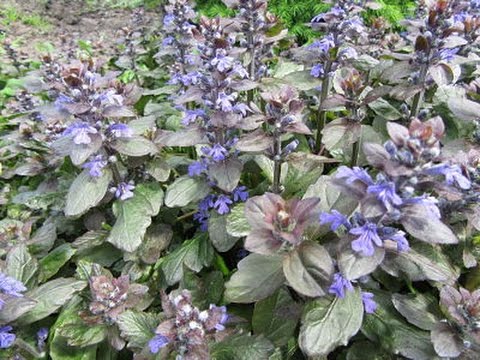

Watch this video on YouTube

